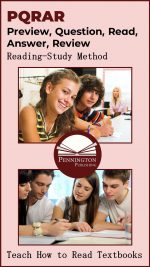How to Read Textbooks with PQ RAR
Many of us remember the old stand-by: the SQ3R reading-study method. Designed to improve reading comprehension of textbooks, the SQ3R method did help the reader to read expository text differently than narrative text. However, this method sorely needs an update to connect with recent reading research regarding what techniques best improve comprehension and retention of expository-based textbooks.
Try the PQ RAR reading-study method as you read or teach your next textbook chapter.
P-First of all, preview the reading selection. Try to limit the reading selection to a manageable size. Overly long chapters, say over six pages for elementary students, eight for middle school students, twelve for high school students, and sixteen for college students should be “chunked” into manageable reading sections.
1. Preview the first and last paragraphs of the chapter and the chapter review, if one is provided.
2. Preview all subtitles and any book study helps at the beginning of the chapter.
3. Preview all graphics such as photographs, charts, maps, etc. and their captions.
Q–Secondly, make use of text-based questions to read textbooks effectively. Good questions produce good answers and significantly increase expository comprehension. Determining questions before reading provides a purpose for reading, that is-to find the answers as you read.
1. Develop questions from the subtitles and write these down on binder paper or on your computer, skipping lines between each question. Try “What,” “How,” and “Why” question-starters. Avoid the “Who” and “When” questions, as these tend to focus attention on the minor details of expository text.
2. Write down any chapter review questions not covered by your subtitle questions, skipping lines between each question.
R–Read the chapter and “talk to the text” by taking notes in the textbook margins. Use yellow stickies and paste them in the textbook margins, if you can’t write in the textbook. Write down comments, questions, predictions, and connections to other parts of the reading and your own life experiences. List examples, key details, and important terms with their definitions. Internal monitoring of the author’s train of thought and the connection to your own knowledge and experience increases comprehension as you read textbooks.FREE DOWNLOAD TO ASSESS THE QUALITY OF PENNINGTON PUBLISHING RESOURCES: The SCRIP (Summarize, Connect, Re-think, Interpret, and Predict) Comprehension Strategies includes class posters, five lessons to introduce the strategies, and the SCRIP Comprehension Bookmarks.
Get the SCRIP Comprehension Strategies FREE Resource:
![]()
A–Answer both the subtitle questions and the book questions as you read. Write down your answers underneath your questions. Don’t be concerned if the textbook did not answer some of your reader-generated questions.
R–Review the questions and answers within the next 24 hours to minimize the effects of the “forgetting cycle.” Generate possible test questions and develop memory tricks for key concepts and details.
*****
The Science of Reading Intervention Program
The Science of Reading Intervention Program: Word Recognition includes explicit, scripted instruction and practice with the 5 Daily Google Slide Activities every reading intervention student needs: 1. Phonemic Awareness and Morphology 2. Blending, Segmenting, and Spelling 3. Sounds and Spellings (including handwriting) 4. Heart Words Practice 5. Sam and Friends Phonics Books (decodables). Plus, digital and printable sound wall cards and speech articulation songs. Print versions are available for all activities. First Half of the Year Program (55 minutes-per-day, 18 weeks)
The Science of Reading Intervention Program: Language Comprehension resources are designed for students who have completed the word recognition program or have demonstrated basic mastery of the alphabetic code and can read with some degree of fluency. The program features the 5 Weekly Language Comprehension Activities: 1. Background Knowledge Mentor Texts 2. Academic Language, Greek and Latin Morphology, Figures of Speech, Connotations, Multiple Meaning Words 3. Syntax in Reading 4. Reading Comprehension Strategies 5. Literacy Knowledge (Narrative and Expository). Second Half of the Year Program (30 minutes-per-day, 18 weeks)
The Science of Reading Intervention Program: Assessment-based Instruction provides diagnostically-based “second chance” instructional resources. The program includes 13 comprehensive assessments and matching instructional resources to fill in the yet-to-be-mastered gaps in phonemic awareness, alphabetic awareness, phonics, fluency (with YouTube modeled readings), Heart Words and Phonics Games, spelling patterns, grammar, usage, and mechanics, syllabication and morphology, executive function shills. Second Half of the Year Program (25 minutes-per-day, 18 weeks)
The Science of Reading Intervention Program BUNDLE includes all 3 program components for the comprehensive, state-of-the-art (and science) grades 4-adult full-year program. Scripted, easy-to-teach, no prep, no need for time-consuming (albeit valuable) LETRS training or O-G certification… Learn as you teach and get results NOW for your students. Print to speech with plenty of speech to print instructional components.
SCIENCE OF READING INTERVENTION PROGRAM RESOURCES HERE for detailed product description and sample lessons.
Get the Diagnostic ELA and Reading Assessments FREE Resource:![]()
Get the Syllable Awareness Assessment FREE Resource:
![]()
Get the Syllable Rules FREE Resource:
![]()
Get the Accent Rules FREE Resource:
![]()
Literacy Centers, Reading, Spelling/Vocabulary, Study Skills

